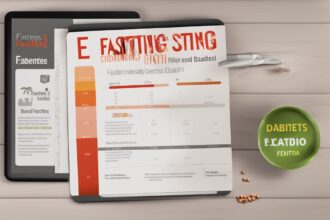Hey there! If you’re looking to take charge of your health and achieve better diabetes control, you’ve come to the right place. Managing diabetes can feel like a daunting task, but with the right strategies—especially when incorporating fasting as a tool—it’s entirely possible to live a vibrant, balanced life. Whether you’re dealing with type 2 diabetes or supporting a loved one, this guide will walk you through practical, science-backed approaches to manage blood sugar levels, improve insulin sensitivity, and enhance overall wellness. Let’s dive into how fasting, alongside other lifestyle tweaks, can be a game-changer for diabetes management.
What Is Diabetes, and Why Is Control So Important?
Diabetes is a chronic condition where the body struggles to regulate blood sugar (glucose) levels, either due to insufficient insulin production (type 1) or insulin resistance (type 2). Uncontrolled diabetes can lead to serious complications like heart disease, kidney failure, and nerve damage. That’s why diabetes control is critical—it’s not just about managing numbers on a glucometer; it’s about protecting your long-term health. According to the World Health Organization, over 422 million people worldwide live with diabetes, and the numbers are rising (WHO, 2023). The good news? Lifestyle changes, including diet and fasting, can significantly improve blood sugar regulation, especially for type 2 diabetes (American Diabetes Association, 2022).
How Fasting Supports Diabetes Control
Fasting, the practice of abstaining from food for specific periods, has gained attention as a powerful tool for blood sugar managementdiabetes control, fasting can also promote weight loss—a key factor in managing type 2 diabetes—since excess body fat often contributes to insulin resistance. However, it’s not a one-size-fits-all solution, and consulting a healthcare provider before starting is essential, especially if you’re on medication.
Practical Tips for Fasting with Diabetes
If you’re new to fasting or curious about integrating it into your diabetes management plan, start slow and prioritize safety. Here are some actionable tips to guide you:
- Start with Short Fasts: Begin with a 12-hour overnight fast (e.g., stop eating at 7 PM and eat again at 7 AM) to ease your body into the rhythm.
- Monitor Blood Sugar Closely: Check your levels before, during, and after fasting to ensure they remain stable and avoid hypoglycemia.
- Stay Hydrated: Drink plenty of water during fasting periods to prevent dehydration, which can affect blood sugar.
- Break Fasts Wisely: Opt for nutrient-dense, low-glycemic foods like vegetables, lean protein, and whole grains to avoid sudden spikes.
- Consult Your Doctor: If you’re on insulin or other medications, adjustments may be needed to prevent complications during fasting.
Balancing Nutrition for Optimal Blood Sugar Regulation
Beyond fasting, what you eat plays a massive role in diabetes control. Focusing on a balanced diet can complement fasting efforts and keep your blood sugar steady. Studies suggest that a diet rich in fiber, healthy fats, and lean proteins can improve glycemic control (Evert et al., 2019). During eating windows, prioritize foods that don’t cause rapid blood sugar spikes. Think leafy greens, nuts, seeds, and fatty fish over processed carbs and sugary snacks. Pairing fasting with mindful eating creates a synergistic effect, helping you maintain glucose stability while supporting overall health. Timing matters too—eating earlier in the day during fasting protocols may enhance metabolic benefits, as your body’s insulin sensitivity is often higher in the morning (Sutton et al., 2018).
Other Lifestyle Habits to Enhance Diabetes Management
Fasting isn’t the only piece of the puzzle for managing diabetes. A holistic approach amplifies results. Regular physical activity, for instance, boosts insulin sensitivity and helps lower blood glucose levels naturally (Colberg et al., 2016). Stress management is another often-overlooked factor—chronic stress raises cortisol, which can spike blood sugar. Practices like meditation or even a simple daily walk can make a difference. Let’s break down some complementary habits to support your journey:
- Exercise Regularly: Aim for at least 150 minutes of moderate activity weekly, like brisk walking or cycling.
- Prioritize Sleep: Poor sleep disrupts hormones that regulate hunger and blood sugar—aim for 7-9 hours nightly.
- Manage Stress: Try mindfulness or deep breathing exercises to keep stress hormones in check.
- Track Progress: Use a journal or app to log fasting times, meals, and blood sugar readings for accountability.
Potential Risks and How to Avoid Them
While fasting offers benefits for diabetes control, it’s not without risks, especially if approached carelessly. Hypoglycemia (low blood sugar) is a major concern, particularly for those on insulin or certain medications. Fasting for too long or without proper preparation can also lead to fatigue, irritability, or nutrient deficiencies. To stay safe, always work with a healthcare professional to tailor fasting to your needs. Avoid extended fasts (beyond 24 hours) unless under medical supervision, and listen to your body—if you feel dizzy or unwell, break the fast. The goal of blood sugar management is sustainability, not pushing yourself to extremes.
Studies and Surveys on Fasting and Diabetes Control
A growing body of research supports fasting as a strategy for diabetes control. A 2018 study published in Cell Metabolism explored time-restricted eating (a form of intermittent fasting) and found that participants with type 2 diabetes who ate within a 6-hour window daily showed improved insulin sensitivity and reduced blood pressure, even without significant weight loss (Sutton et al., 2018). Another trial, published in BMJ Case Reports in 2018, documented three patients with type 2 diabetes who, under medical supervision, used intermittent fasting and reduced or eliminated their need for insulin within months (Furmli et al., 2018). These studies highlight fasting’s potential but emphasize the need for personalized plans and professional guidance to ensure safety and effectiveness.
Wrapping up, achieving diabetes control through fasting and lifestyle changes is not only possible but can be incredibly empowering. It’s about finding a rhythm that works for you—whether that’s intermittent fasting, mindful eating, or staying active. Remember, small, consistent steps lead to big results. Work closely with your healthcare team to customize your approach, monitor your progress, and celebrate every win along the way. Managing diabetes isn’t just about restrictions; it’s about reclaiming your health and living life on your terms. What’s one step you’ll take today toward better blood sugar management? Let’s start this journey together!
References
- American Diabetes Association. (2022). Standards of Medical Care in Diabetes—2022. Diabetes Care, 45(Supplement 1), S1-S264.
- Colberg, S. R., Sigal, R. J., Yardley, J. E., et al. (2016). Physical Activity/Exercise and Diabetes: A Position Statement of the American Diabetes Association. Diabetes Care, 39(11), 2065-2079.
- de Cabo, R., & Mattson, M. P. (2019). Effects of Intermittent Fasting on Health, Aging, and Disease. New England Journal of Medicine, 381(26), 2541-2551.
- Evert, A. B., Dennison, M., Gardner, C. D., et al. (2019). Nutrition Therapy for Adults With Diabetes or Prediabetes: A Consensus Report. Diabetes Care, 42(5), 731-754.
- Furmli, S., Elmasry, R., Ramos, M., & Fung, J. (2018). Therapeutic use of intermittent fasting for people with type 2 diabetes as an alternative to insulin. BMJ Case Reports, bcr-2017-221854.
- Sutton, E. F., Beyl, R., Early, K. S., et al. (2018). Early Time-Restricted Feeding Improves Insulin Sensitivity, Blood Pressure, and Oxidative Stress Even without Weight Loss in Men with Prediabetes. Cell Metabolism, 27(6), 1212-1221.
- World Health Organization. (2023). Diabetes Fact Sheet. Retrieved from WHO website.






